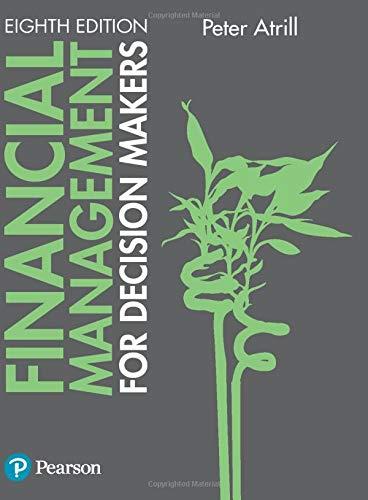Question
Use the information below for Parts A -E . Stock X, Y, and Z are all part of the S&P 500, or large cap US
Use the information below for Parts A -E .
Stock X, Y, and Z are all part of the S&P 500, or large cap US index. The S&P 500 is considered the market and each stocks beta measures the stocks sensitivity to the. A US ten year bond is a reasonable proxy for the risk free rate. Below is some information on a $400M Portfolio XYZ, which is comprised of Stocks X, Y, and Z.
|
| Stock X | Stock Y | Stock Z |
| Price Per Share ($) | $ 60.92 | $ 45.61 | $ 59.50 |
| Weight in Portfolio XYZ ($M) | $ 100.0 | $ 200.0 | $ 100.0 |
| Dividend Yield | 0.00% | 0.00% | 2.00% |
| Variance of Returns | 3.60x10^-3 | 1.00x10^-2 | 1.44x10^-2 |
| Beta of Stock | 0.80 | 1.25 | 1.50 |
| Expected Total Return (CAPM) | 6.70% | 9.63% | 11.25% |
| Risk Free Rate (US 10 Yr) | 1.50% | 1.50% | 1.50% |
A. Using the expected total return of each stock using the CAPM/SML, Portfolio XYZ will have an expected return of __________ and __________.
1. 9.2% ; 9.3% of market risk
2. 9.3% ; 9.3% of market risk
3. 9.3% ; less market risk than the S& P 500
4. 9.2% ; the same amount of market risk as the S&P 500
5. 9.3% ; more market risk than the S&P 500
B. Recall that the Total Return of a stock can be decomposed into dividend yield and capital gains yield. Use the CAPM/SML to predict each stocks closing price one year from today. One year from today, which of the following statements is (are) TRUE:
I. Stock Z is expected to close at the same price as Stock X
II Stock Z is expected to close at a lower price than Stock Y
III. Stock Y is expected to close at a higher price than Stock X
1. I
2. II
3. III
4. II, III
5. None of the statements
C. The excess return an investor requires to take on the added risk of investing S&P 500 as opposed to a 10 Year US bond (i.e. the market risk premium) is:
1. 6.50%
2. 8.00%
3. 8.25%
4. 9.50%
5. 9.75%
D. Unlike the Treynor Ratio (aka the risk-to-reward ratio on p. 369), the Sharpe Ratio uses total risk instead of systematic risk in the denominator of the calculation. Based on each stocks Sharpe Ratio:
1. Stock X is a better investment than Stock Y or Z
2. Stock Y is a better investment than Stock X or Z
3. Stock Z is a better investment than Stock Y or X
4. Stock Y & Z are both equally better than Stock X
5. Stock X, Y, & Z are equally good investments based on systematic risk
E. If you sold $100 M of Stock Z to buy $100 M of stock X, which of the following statements are TRUE:
I. The portfolios systematic risk would likely decrease
II The portfolios non-diversifiable risk would likely increase
III. The portfolios expected return will most likely increase
1. I
2. II
3. III
4. I&II
5. All of the statements
Step by Step Solution
There are 3 Steps involved in it
Step: 1

Get Instant Access to Expert-Tailored Solutions
See step-by-step solutions with expert insights and AI powered tools for academic success
Step: 2

Step: 3

Ace Your Homework with AI
Get the answers you need in no time with our AI-driven, step-by-step assistance
Get Started


